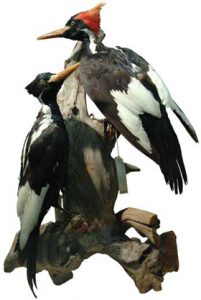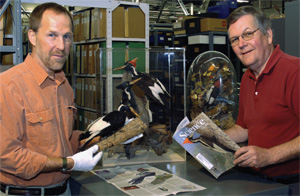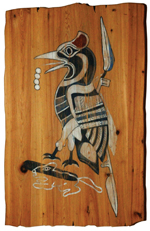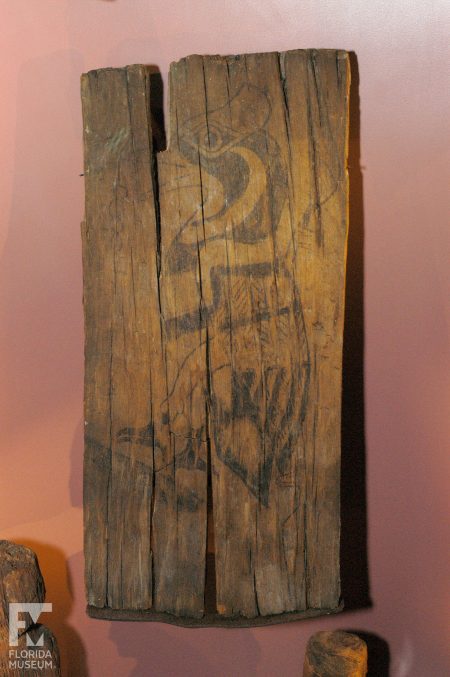
Every so often scientists discover a plant or animal that was thought to be extinct. A dramatic example is the Coelacanth (Latimeria chalumnae), a prehistoric-looking fish found off the coast of Madagascar in 1938. It had been presumed that this type of primitive, lobe-finned fish had not existed for 65 million years.
Closer to home and more recently, scientists at the Cornell Laboratory of Ornithology and The Nature Conservancy announced in April 2005 that their field team had seen (and briefly videotaped) and heard (and briefly audiotaped) one of North America’s most spectacular birds, the Ivory-billed Woodpecker (Campephilus principalis). These events took place at the Big Woods, Cache River National Wildlife Refuge of eastern Arkansas, decades after the last unquestioned sighting of the species in the United States. The report was hailed by some bird enthusiasts as nothing less than finding “nature’s holy grail.” Other scientists remain skeptical that the Ivory-billed Woodpecker is alive in Arkansas. Why is the possible rediscovery of an “extinct” woodpecker so important, and what significance does the bird hold for us in Florida?

Photos by Jeff Gage
The Ivory-billed Woodpecker inhabited old-growth bottomland forests from Texas to North Carolina, northward to southern Illinois and southward through the Florida peninsula. In the 1800s, probably more Ivorybilled Woodpeckers lived in Florida than in any other state, although much of what we know about the species is from a study by James Tanner in Louisiana in the 1930s and 1940s. Large dead or dying trees provided the Ivory-billed Woodpecker with nest cavities and food (woodboring insects). Each pair of the large birds needed from 6 to 16 square miles of mature forest.

Intense logging, especially after the Civil War, converted about 24 million acres of old-growth forest in the Southeast to a mere 4.5 million acres of scattered, mostly second-growth forest. By the early 1900s, most tracts of mature forest large enough to sustain a population of the massive woodpeckers were gone from Florida and elsewhere. The last generally believed sightings of the Ivory-billed Woodpecker in the U.S. were in Central Florida in the 1950s and 1960s. A separate population existed until just a decade or two ago in mature pine forests of eastern Cuba.
The prehistoric Calusa people of South Florida must have thought that the Ivory-billed Woodpecker was special, because they painted images of this magnificent bird, which may be seen at the Florida Museum of Natural History’s South Florida People and Environments permanent exhibition hall. The woodpecker’s size alone (an 18-20 inch body and 30-31 inch wingspan) probably impressed the Calusa, not to mention the black plumage with bright white patches on the wings and white “racing stripes” along the back and neck. The bright red crest of the male set it apart from the black-crested female.

Florida Museum photo by Kristen Grace
Frankly (and sadly), we are not optimistic that the Ivorybilled Woodpecker will return again to Florida, where large tracts of old-growth forest simply no longer exist. During just 10 years (1990 to 2000), Florida’s population grew by 3 million people, an increase of 23.5 percent. In spite of progress in saving land through programs such as Florida Forever, large areas of natural and semi-natural habitat are being lost each month to accommodate our growing population.
Nevertheless, with the possible rediscovery of the Ivory-billed Woodpecker in Arkansas, and the outside chance that it may still exist in remote areas of eastern Cuba, not all hope is lost. Forests do mature with time, and there is no better time than right now to set aside what remains of Florida’s once seemingly endless expanses of forests and wetlands.
Nothing would make us happier than to learn that the Ivory-billed Woodpecker still exists in the wild. As we write (February 2006) a research team is combing the Big Woods for more evidence. Please stay tuned (and keep your fingers crossed) as events in Arkansas unfold. If the Ivory-billed Woodpecker survives there, then we can have renewed hope that again it will haunt the forests of Florida. Wouldn’t that be marvelous?
David M. Jarzen is a Courtesy Research Scientist at the Florida Museum of Natural History who studies the nature of plant life in Florida and the Caribbean during the geological past. David W. Steadman is Curator of Ornithology at Florida Museum, and an expert on bird extinctions worldwide.
Learn more about the Ornithology Collection at the Florida Museum.